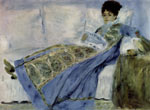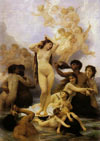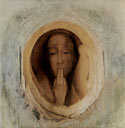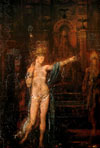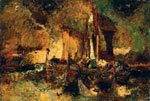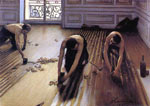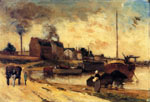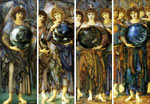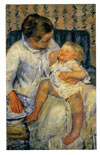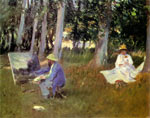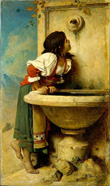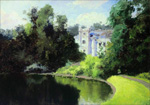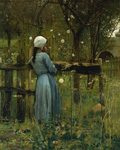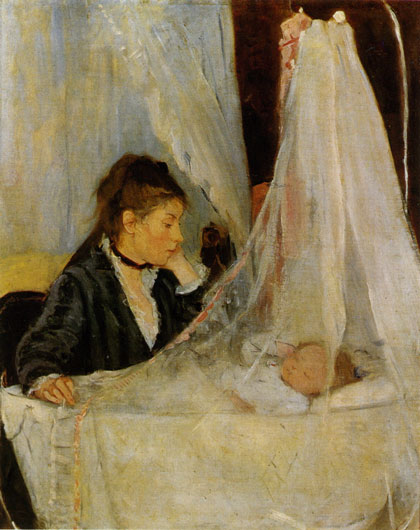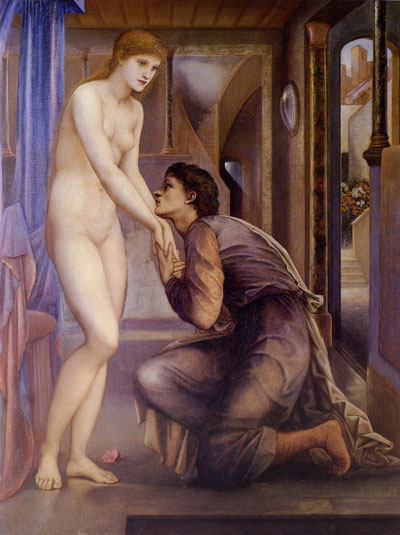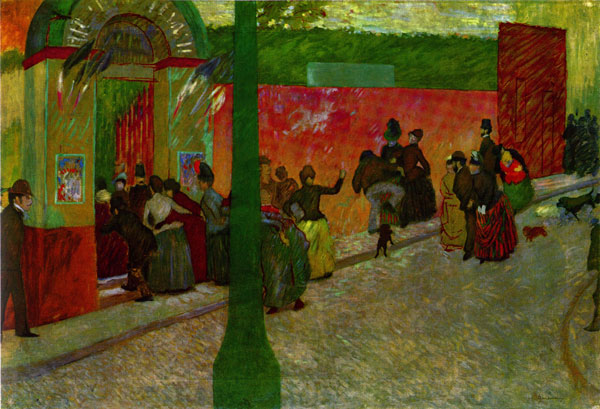
Moving Movements, History of Modern Painting, 1870 - 80
THE YEARS 1870 - 1880
A turbulent and bloody time.
In 1870 France was at war with Prussia and the German states. In 1871
was signed for peace. Alsace and Lorraine were connected again to Germany. After the death of the third Napoleon France became a republic again. In May '71 there was a movement striving to a socialist state, which included the lower middle class, the proletariat and the artists.
In the "bloody week", the "semaine sanglante", in 1871, this movement was suffocated in blood. Most artists were incorporated in the army. Pissarro
fled, his house had been burned down, together with hundreds of his paintings.
In Paris between 1871 and 1903, 155000 women were registered as prostitutes, the police also arrested 725000 clandestine.
Colonialism was flourishing, in the last quarter of the 19th century one fifth of the worlds population was under white rule.
In the years 1870 - 80 Koch discovered divers bacteria's with the microscope.
In 1878 the Bell Telephone Company was founded. In 1877 the phonograph was invented. Photography was now witness of wars and rebellion. In
1868 De Hauron achieved the first patent on colour photography. In 1879
plates of bromide-silver-gelatine plates made shots in a fraction of a second. In 1888 the first reel of film camera came on the market, "Kodak
no. 1".
In 1854 Japan became open for trade from America and Europe.
After the wave of "chinoiseries" now came "le japonisme"
in fashion, on the world expositions of '62 en '67 there were a lot of Japanese
art pieces.
click the thumbnails
Auguste Renoir
Madame Monet reading in a sofa
Claude Monet
Le Déjeuner
Paul Cézanne
Baigneuses 1874
Auguste Renoir
Moulin de la Galette
William Bouguereau
Naissance de Venus
Odilon Redon
The Silence
Odilon Redon
Melancholy
Gustave Moreau
Salomé 1876
Gustave Moreau
Phaeton 1878
Pierre-Cécile Puvis de Chavannes
Young Girls at the Edge
of the Sea 1879
Jean-Babtiste Carpeaux
Bal au Tuileries
Adolphe Joseph Thomas Monticelli
Before the storm
Adolphe Joseph Thomas Monticelli
Theatre scene
Caillebotte
The Floor Scrapers
Gustave Caillebotte
Rue de Paris, rainy time,
crossing of the Rue de Turin
and the Rue de Moscou 1978
Paul Gaugain
Cail Factories and Quai
de Grenelle 1875
Leon-Augustin L'hermitte
Payment of the Mowers 1882
Leon-Augustin L'hermitte
Fishermen
Jules-Bastien Lepage
Heymakers 1878
Jules-Bastien Lepage
Gathering Potatous 1879
Paul Camille Guigou
Hunters near the
Coast of Marseille 1867
Edward Burne-Jones
Four Days of Creation
Mary Cassat
Mother about to wash
her sleepy Child 1880
John Singer Sargent
Monet painting at the
Edge of the Forest
Frederico Zandomeneghi
La Place d'Anvers in Paris 1880
Gaetano Segantini
Back from the Forest
Leon Bonnat
Fille Romaine à la fontaine,
1875
Whistler
Nocturne in Black and Gold,
the Falling Rocke…
c.1875
Vasily Polenov
Pond in the Park. Olshanka
1877
William Stott of Oldham
Girl in a meadow
1880
Berthe Morisot, le Berceau, 1873 |
French impressionism The so-called impressionists achieved their most beautiful style from 1870. In 1870 Degas already painted his ballerinas, but the orchestra was depicted realistic. He often painted quite soberly until 1877. Berthe Morisot painted in '70 - '71 in colourful realism, with graceful lines. With "Le Berceau" in 1873 her style had become clearly impressionistic, with several transparent colour spots near and above each other, delicate and graceful contour lines following the main lines. Renoir achieved his wonderful style with "Madame Monet lisant le Figaro" from 1872. No contours, nothing but spots and strokes, hazily delineated. Monet painted in 1873 "Le boulevard de capucines": the houses dissolve in a blue haze, the people are black spots, trees are transparent and fleeting silhouettes. The most notable are the snow layers on the cars and a cluster of balloons. Also dating from '73 is "Papots en Argenteuil" and a sunrise on the sea: just a little boat, the rest is abstract, with sometimes very random strokes. Cezanne was experimenting. Sometimes he worked freely, as sketching, with a very expressive effect. He changed from rough forms to vague, suddenly painting precision again. In 1879 started his typical style in little facets. In 1873 Guillaumin already got his specific dramatic colours and granular texture. |
It is interesting to compare Renoir's both versions of the famous "Moulin de la Galette" from 1876. He achieves more light and fresher colours with giving all light spots and all glass some more white. In 1877 they all become more colourful: Morisot, Manet, Sisley, Caillebotte. Monet then painted his train stations. This description shows how different the impressionist techniques are. They have more their subjects in common then their painting technique. The impressionist loved to paint "en plein air": landscapes, the free time of the middle class, the new transport, architecture..., but also still a lot inside: still lifes, models, interiors. They always took care to have the entire subject before them. |
Armand Guillaumin, Onderaande Zon te Evry, ca. 1869 - 71 |
Nevertheless France also had other renewers in that time, equally different from the academics as the impressionists, and regarded equally suspicious by the public. But also completely different from the impressionists. Some French painters from that area are now often classified as "symbolists". Moreover, they also differ a lot from each other.
Odilon Redon, Engel in Kettingen, ca. 1875 |
Pierre Puvis de Chavannes and Gustave Moreau enjoyed some recognition, probably granted at their subjects: mythology, often on large canvas. Their very personal style was not appreciated by everyone. Who did not paint turbulent scenes, was Odilon Redon. His recognition was long time delayed. His symbolism, or even surrealism in his subjects, as well as his impressionistic technique, took a start in the same year 1870, when a lot of his impressionist colleagues found their own style. He worked a lot in graphite and charcoal and was experimenting with diverse techniques to obtain several special effects. His first subjects were fallen angels, for example "The eternal Silence" (1870) or "Angel in Chains" (1875): a very red background with the rough strokes still visible, a rock in large strokes of variating colours. |
Gustave Moreau, l' Apparition, 1876 |
The wings of the angel are unnatural short, the normal form was inferior to the expression. Also his "Executing Angel" from 1876 is very expressive with restricted colours, angular, powerful lines, transitions from light to very dark, with diversity in structures of charcoal and gouache, for example with scratches. The subjects of his work were based on meditation, introversion, isolation, the world of the unconscious behind the closed eyelids, the relationship between life, dream and dead. He worked rarely in oil, but for example his "Melancholy" from 1876,
in charcoal, gouache, pastel and black chalk could not have been more splendid in oil; full of scratches and fine lines in diverse colours and nevertheless very browny, without become ashy. Redon was also very influenced by so called primitive civilisations. In the years
1870 several exhibitions were held about this subject. In 1877 a group of cannibals were exhibited in Paris to the public, sitting around a fire.
Redon was very impressed, because those people were living more closely to their unconscious. Redon's fantasy surmounts symbolism and comes more close to the later surrealism: for example "Crying Spider "
(1881), "Strange Flower " (1880), "Cactusman" (1881)...
His fantasy was stimulated by the deep sea world and the creatures discovered under the microscope. In 1860 there was already a sun microscope, projecting the minuscule life on screen. In 1880 theatres showed with the electronic
microscope. Fantin-Latour now paints also symbolism, with a very vague figuration. |

Gustave Moreau, Helena voor de Poort van Scée, ca. 1880
Other styles beside symbolism and impressionism
A lot of painters, such ass Ingres and Bouguereau, kept on painting their portraits, landscapes and dramas photographically until
1880. Francais and Levy painted in the years 1860 mythology with a photographical precision.
We already handled the expressionism in the style of Daumier.
Jean-Babtiste Carpeaux (1827-75), although sober in colours, often painted very sketchy, as in his "Bal aux Tuileries", with unrecognisable figures. Compared with his brush strokes even Monet and Renoir look classic. His subjects nevertheless stayed portraits, battles and ceremonies. Monticelli (1824-1886) painted more free then the future Van Gogh will do, for example in his "Negresse Porteuse d'Oiseaux" (around 1878), the subject is hardly recognisable. (Also see as an example "Theatre Scene", click on the thumbnail on the right colon.).
Caillebotte painted realistic and in 1875 also Gaugain painted realism
in brown colours. His "Etude de nu" is more in
Monet's style, in the same colour technique, but with sharper contours. Also Corot now works more in the new style, he sometimes resembles Degas. The painters Leon-August L'hermitte and Jules Bastien-Lepage were social artists, working more colourful then before.
Some painters had a style more between the academic and impressionism, the one by his colour, the other by the strokes and vagueness, or by the choice of the subject, such as the middle class at the sea. They were never touched by complete impressionism. For example Jongkind,
or Boudin who continued to bring his own style to perfection until 1880.
Also the wonderful and sharper Guigou, or the vaguer, to abstract evolving
Ravier.
Edward Burne-Jones, Pygmalion and the Image - the Soul attains, 1868 - 1878 |
Revolution in painting in other countries In England the group of Pre-Raphaelites and their equals surmounted all others. Rossetti started to paint ever more precise: see for example "Dante's dream".
Edward Burne-Jones' "Seven days of Creation" (1870 - 76), is in
watercolour, gouache and gold shell on canvas. Painstakingly precise, strongly contoured, in cheerful soft colours (now wrongly called "pastel colours"), with ever the same female person.
The series of "Pygmalion" (1868 - 78) is in oil, the different colours are radiating through each other, often covered by several thin layers of glacis. |
![]()
Federico Zandomeneghi, Il Moulin de la Galette, 1878 |
Also Italy has impressionists which don't score high, such as Fattori or Signorini. But of high level is Zandomeneghi, using bright and unreal colours for example in his "Moulin de la Galette" from 1878, as the future fauvists will do, but still keeping sharp contours. Segantini painted from 1884 to nature as well as symbolism, he made his canvas radiating brightly by his typical thin lines in different fine colours, melting together when looked at from a distance as in impressionism, but his technique creates a softer mood without rough strokes. |
Previati will use this very same technique in the years '90, and he was also a painter of nature and the lower class people, as well of symbolism. If there is a third great art country around the changing of the century, apart from France and England, it was surely Poland. In that time Poland was still ruled by the academic dictatorship of Matejko. De most original painter was Gottlieb: although he could paint very academic, his "Ahasverus" from 1876 looks as contemporarily art. In "Salome", 1878, a wonderful figure arises from the crisscross of stripes, spots and scratches. Aleksander Gierymski still worked in 1873 in the old style, later on he will become a wonderful impressionist, as to see in "Summer House" (around 1876), "Italian Garden" (1895, 97). His "In the Summer House" from 1882 is sharp, but the colours and sparkling light resemble Monet. Copyright for the text of all pages of this History of Modern Painting: Johan Framhout; text written in 1990-92; revisionned and put on the internet in 2005; translation in English 2012
|
Maurycy Gottlieb, Salome z glowq 'sw. Jana, ca. 1878 |

